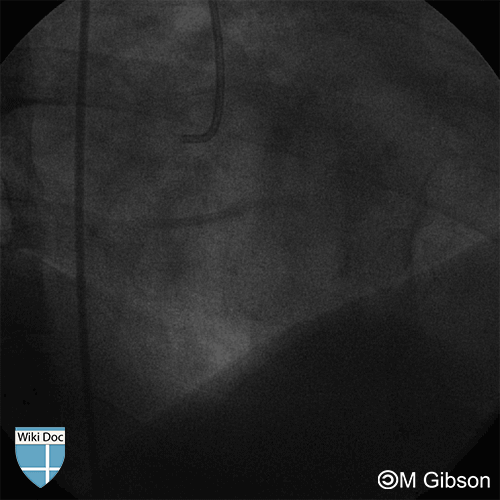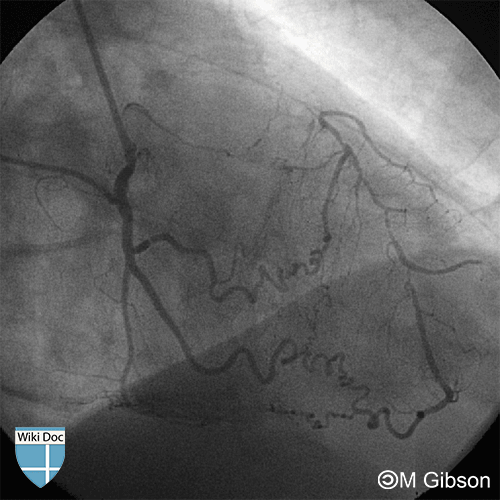Coronary collaterals
Editor-In-Chief: C. Michael Gibson, M.S., M.D. [1]; Associate Editor(s)-in-Chief: Hilda Mahmoudi M.D., M.P.H.[2]; Rim Halaby, M.D. [3]
Overview
Coronary collateral arteries bypass the blockage in the main artery and supply enough oxygenated blood to enable the cardiac tissue to survive and recover.
Criteria to Distinguish Between a Parent Epicardial Vessel And A Collateral Vessel
If a vessel meets any of these criteria, it is considered a collateral vessel.
- If the vessel anastomoses with a distal segment of the same epicardial artery.
- If the vessel anastomoses with another vessel classified as a collateral.
- If the vessel has a mean diameter <0.7 mm.
- If the vessel (<0.7 mm) extends beyond one half of the distance between the epicardial artery segment that it originates from and any adjacent epicardial artery segment.
- If the vessel arises at a branch angle <135 degrees from the upstream vessel, thereby deviating from the normal range of epicardial branching angles.
- If the vessel has excessive tortuosity manifested by either a sine wave appearance or by a doubling back on itself.
- If the vessel has a corkscrew appearance.
- If the vessel is a branch arising from a major epicardial artery that was not apparent at both initial and follow-up time points.
Branches are not considered to be collaterals if any of the following criteria is met:
- The distal bifurcation of the left anterior descending artery (commonly referred to as the “moustache,” “whale’s tail,” or “pitchfork”) as long as each branch does not extend beyond 10 mm from the parent artery.
- Septal branches that do not extend more than half the distance to the inferior border of the heart.
- Diagonal branches that follow a conventional 30- to 45-degree branch pattern off the left anterior descending artery.
- Acute marginal branches in the right coronary artery may arise at an acute angle but are not considered collaterals if they are >0.7 mm unless they meet any of the aforementioned criteria.
- The sinoatrial and atrioventricular nodal branches of the right coronary artery are not considered collaterals unless they meet the aforementioned criteria for length or termination at an epicardial artery.
Collateral Flow Grade
Grade 0 flow
There is no flow in the collateral. This would be documented if a collateral had been visible at one time point but was not angiographically appar- ent at the other time point.
Grade 1 flow
The collateral is barely apparent. Dye is not visible throughout the cardiac cycle but is pre- sent in at least 3 consecutive frames. There may not be clear antegrade dye motion in the collateral; it fills faintly and diffusely. There may be no clear connection with a major epicardial artery or side branch.
Grade 2 flow
The collateral is moderately opaque but is present throughout at ≥75% of the cardiac cycle. There is antegrade motion of the dye rather than diffuse filling.
Grade 3 flow
The collateral is well opacified and the column of dye is well defined (ie, >0.5 mm in diameter) but is <0.7 mm wide throughout the majority of its length. The collateral has clear antegrade dye motion.
Grade 4 flow
The collateral is well opacified, fills antegrade, and is very large. It is >0.7 mm in diameter throughout its entire length.
Grading System
Angiographic assessment of apparent collaterals is useful to quantify the angiogenic response to interventions designed to enhance myocardial perfusion and function in ischemic myocardium.[1] [2][3] Collateral circulation is assessed visually using the following grading system:
Grade 0: No collaterals present
Angiography fails to reveal evidence of collateral vessels.
Grade 1: Partial Collaterals
Partial collaterals are collaterals which fill branches of a major epicardial branch, but not the major artery itself. There is evidence of minimal to partial filling of the recipient branch epicardial arteries/infarct region. It is not necessary for one to see the branches connect directly to the major epicardial artery.
Grade 2: Complete Collaterals
Complete collaterals are well-developed collaterals which fill into a major epicardial branch, regardless of whether dye reaches the lesion which is collaterized or not. Bridging collaterals, a subgroup of complete collaterals, arise from the culprit vessel and fill the major epicardial branch of the culprit vessel.
Grade 3: Myocardial Collaterals
Myocardial collaterals are collaterals which participate in the perfusion of the myocardium, but do not fill any visible arterial branch.
Angiography Examples
Shown below are an animated image and a static image depicting collateral artery between the RCA and the LAD. Outlined in yellow in the image on the right is the collateral artery.
Additional Examples
Click here for more examples of coronary collaterals.
References
- ↑ Fuchs S. Lack of correlation between angiographic grading of collateral and myocardial perfusion and function. Coron Ar Disease 2001; 12: 173-78.
- ↑ Abbott JD, Choi EJ, Selzer F, Srinivas VS, Williams DO Impact of Coronary Collaterals on Outcome Following PCI [from the NHLBI Dynamic Registry]. Am J Cardiol. 2005; 96: 676–680.
- ↑ Koerselman J, van der Graaf Y, de Jaegere PP, Grobbee DE. Coronary Collaterals an Important and Underexposed Aspect of Coronary Artery Disease. Circulation. 2003; 107: 2507-2511.

